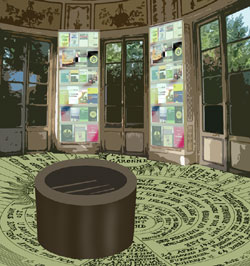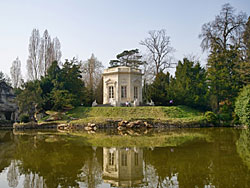|
Suzanne
Treister The Spaceships of Bordeaux: The Well/Library Concerning A Technological Society PROPOSAL IMAGES AND CONCEPT:
|
|||
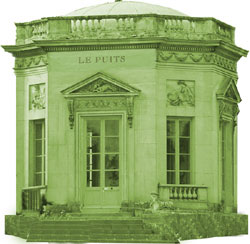 |
|||
|
Le
puits/The Well: original plan for
interior |
Le
puits/The Well:
proposed view
from one side |
Le
puits/The Well:
proposed view
from other side (Bibliothèque Jacques Ellul) |
|
|
Concept : In a previous work of mine, HEXEN 2.0 (2009-11)1, which documented histories and ideological positions in relation to the pros and cons of advancing technological societies, I had come across the work of Jacques Ellul whose ideas I admired, in particular his ideas on technology which he wrote about in 'La technique ou l'enjeu du siècle'/'The Technological Society' (1954). "The Technological Society is one of the most important books of the second half of the twentieth century. In it, Jacques Ellul convincingly demonstrates that technology, which we continue to conceptualize as the servant of man, will overthrow everything that prevents the internal logic of its development, including humanity itself -- unless we take the necessary steps to move human society out of the environment that 'technique' is creating to meet its own needs." - From synopsis of English translation On the way to the submarine base, in the car with Marion from Bordeaux Métropole, I mentioned Ellul's name in relation to another subject and she told me that his son had been her history teacher at school and that Ellul was from Bordeaux and had taught at the university here. I was amazed and excited as I had not realised he was a Bordeaux man and I looked forward to discovering more on subsequent trips, maybe there was a personal archive or library of his books I could visit. On my return to London I read about how much Jacques Ellul loved his city and also that he had been involved in the French Resistance during the second world war. It then struck me as ironical that the city he loved so much would no longer exist if not for the complex technologies which were ideologically problematic for him. Naturally one finds these inbuilt contradictions everywhere, and I had found many in the ideas of the thinkers I had included in HEXEN 2.0 and tried to figure out ways of resolving some of these in my mind, especially the ideas of the anarcho-primitivists, or at least of presenting the information so that audiences could discuss the issues at stake in relation to how to think about possible futures and the future of technologies and their usage in social and political contexts. I wondered about finding a way of presenting Ellul's ideas more overtly in the city, of bringing about a confrontation between these conflicting issues to do with technology which had been preoccupying me. I had the idea to make a pavilion in the centre of Bordeaux, on the promenade/quayside, which would be a library of his works. The
pavilion would be in a style of architecture sympathetic to the
historical architecture of Bordeaux and I felt that the Belvedere
pavilion located on the grounds of Le Petit Trianon at the Palace of
Versailles would make the perfect model.2 The Ellul pavilion would be
like a camouflage, a mirror of the Bordeaux historical style, made
with contemporary materials. I envisioned at the centre of this pavilion a well leading down to the waters of the Garonne, waters which without the help of technology would flood upwards to emerge as a fountain into the pavilion and destroy the books, thus creating and representing a physical tension of ideas. Like a dormant volcano, to trigger a response from the audience, whilst encouraging passersby to engage in the writing of one of Bordeaux's greatest thinkers. This was the beginning of the idea for The Well/Jacques Ellul Library. The Well will contain many relevant books by Ellul and also specific key texts by writers with related critical concerns regarding technology and civilisation, e.g. Martin Heidegger, Walter Benjamin, Theodore Adorno and Max Horkheimer, Lewis Mumford, Joseph Weizenbaum, Ivan Illich, Guy Debord, Neil Postman, Langdon Winner, Fredy Perlman, John Zerzan, David Watson, Hakim Bey, Bob Black, Derrick Jensen and Lawrence Jarach. There will be information on how to borrow these books from the University or elsewhere. For the display of the books there will be four internal and four external vitrines, eight in total. One of these vitrines will be reserved for a temporary changing display. This vitrine will be curated in collaboration with Patrick Chastenet, Professor of Political Science at the Centre Montesquieu de Recherche Politique, Université Montesquieu - Bordeaux IV and President of l'Association Internationale Jacques Ellul (AIJE). This curated vitrine will show reprints and new translations into other languages of Ellul's works and new related publications by writers from around the world. The responsibility for the process and task of maintaining this living section of the library will be handed down indefinitely through the generations under the aegis of the University of Bordeaux. In this way writers, philosophers and theorists who are responding to their own contemporary issues of technology and society, in let's say 100 or 500 years time, and if the current society will allow it, may have their works displayed in the pavilion, perhaps in another format than a book, or perhaps the format of the book will survive? And if not then The Well will eventually also become a memorial to a lost technology. The Well/Jacques Ellul Library will also be a potential site for events hosted by Patrick Chastenet and others, since it is an open space for the public to use. On the exterior of The Well will be an information text. The text will include a short biography of Jacques Ellul mentioning also the other writers, information about the well at its centre, about the overall Garonne project of which it is a part, reference to the other two components of my project (The Spaceship and The Observatory) and to the accompanying book, Les Vaisseaux de Bordeaux, which can be seen/purchased at the nearby CAPC-musée d'art contemporain de Bordeaux. The proposed location is in the Parc aux Angeliques. Just on the opposite bank of the Garonne, in Place des Quinconces, are already located statues of two key Bordeaux writers, statesmen and thinkers, Montaigne and Montesquieu. The nearby addition of a pavilion dedicated to the ideas of Jacques Ellul would make a perfect triangle and with the indefinite updating of the Ellul library by the University of Bordeaux, would be a vehicle for the dissemination of perpetually current social and political ideas into the future. |
|||
 |
 |
 |
|
| Le puits/Bibliothèque Jacques Ellul/Livres 1936-1963 | Le puits/Bibliothèque Jacques Ellul/Livres 1964-1975 | Le puits/Bibliothèque Jacques Ellul/Livres 1971-1977 | |
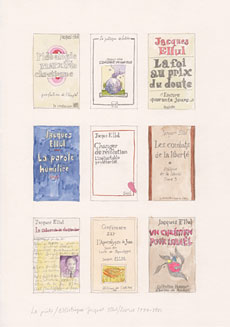 |
 |
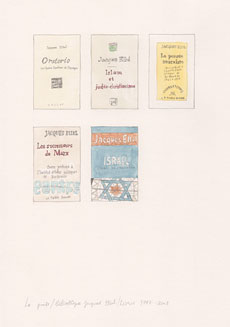 |
|
| Le puits/Bibliothèque Jacques Ellul/Livres 1979-1986 | Le puits/Bibliothèque Jacques Ellul/Livres 1987-1995 | Le puits/Bibliothèque Jacques Ellul/Livres 1997-2008 | |
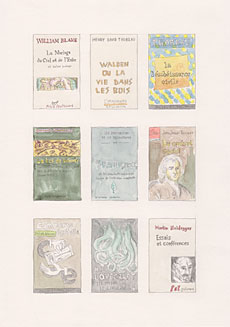 |
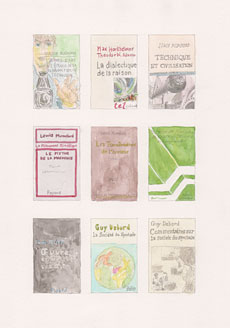 |
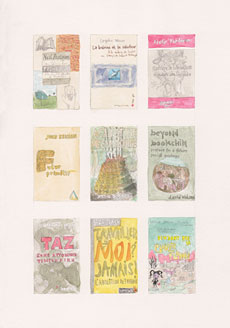 |
|
| Le puits/Bibliothèque Jacques Ellul/Livres des autres 1652-1954 | Le puits/Bibliothèque Jacques Ellul/Livres des autres 1936-1988 | Le puits/Bibliothèque Jacques Ellul/Livres des autres 1992-2010 | |
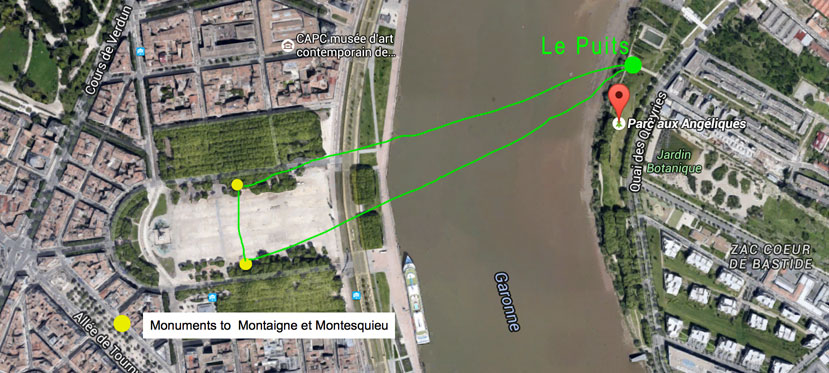 Background references : |
|||
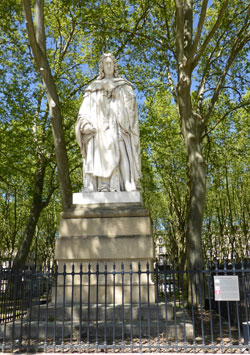 |
Commissioned by the city of Bordeaux in 1834, the two colossal white Carrara marble statues of Montaigne and Montesquieu were executed between 1843 and 1874 by the sculptor Dominique, Félix Maggesi (Cararra, 2801 - Bordeaux 1892). Originally destined to stand in the Allées de Tourny, the two works were finally placed in the hemicycle of the Parc des Quinconces and inaugurated on September 5, 1858. L: Charles de Secondat, baron de la Brède et de Montesquieu (Château de La Brède 1689 - Paris 1755) is represented wearing his official costume as président à mortier of the Bordeaux Parlement, a position he occupied from 1716 to 1726. R: Michel Eyquem de Montaigne (Château de Montaigne, Dordogne, 1533-1592) is represented wearing his mayor's robe, a position he occupied from 1581 to 1585. |
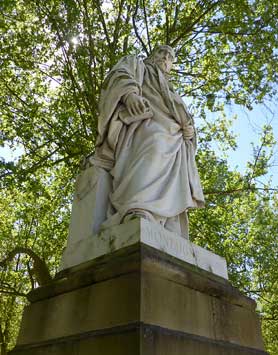 |
|
 |
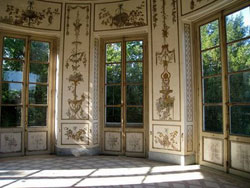 |
||
|
Belvedere Pavilion in the grounds of the Petit Trianon of Versailles, built between 1778 and 1781 *
"The Petit Trianon and its park are indissociably linked
to the memory of Queen Marie-Antoinette. She is the only queen
to have imposed her personal taste on Versailles. Sweeping away
the old court and its traditions, she insisted on living as she
wished. In her Trianon domain, which Louis XVI gave her in 1774,
she found the heaven of privacy that enabled her to escape from
the rigours of court etiquette. Nobody could come there without
her invitation. The reinstatement of the compound which shows
most of the former arrangement: enclosing walls, gates, grills
and saut-de-loup [Wolf's jump] - shows the Petit Trianon domain
as a guarded, preserved place, centred on its château. This
arrangement shows the eclecticism and refinement of Marie-Antoinette,
an art of living linked to free thinking, for the spirit of the
Enlightenment was far from absent here." |
|||

